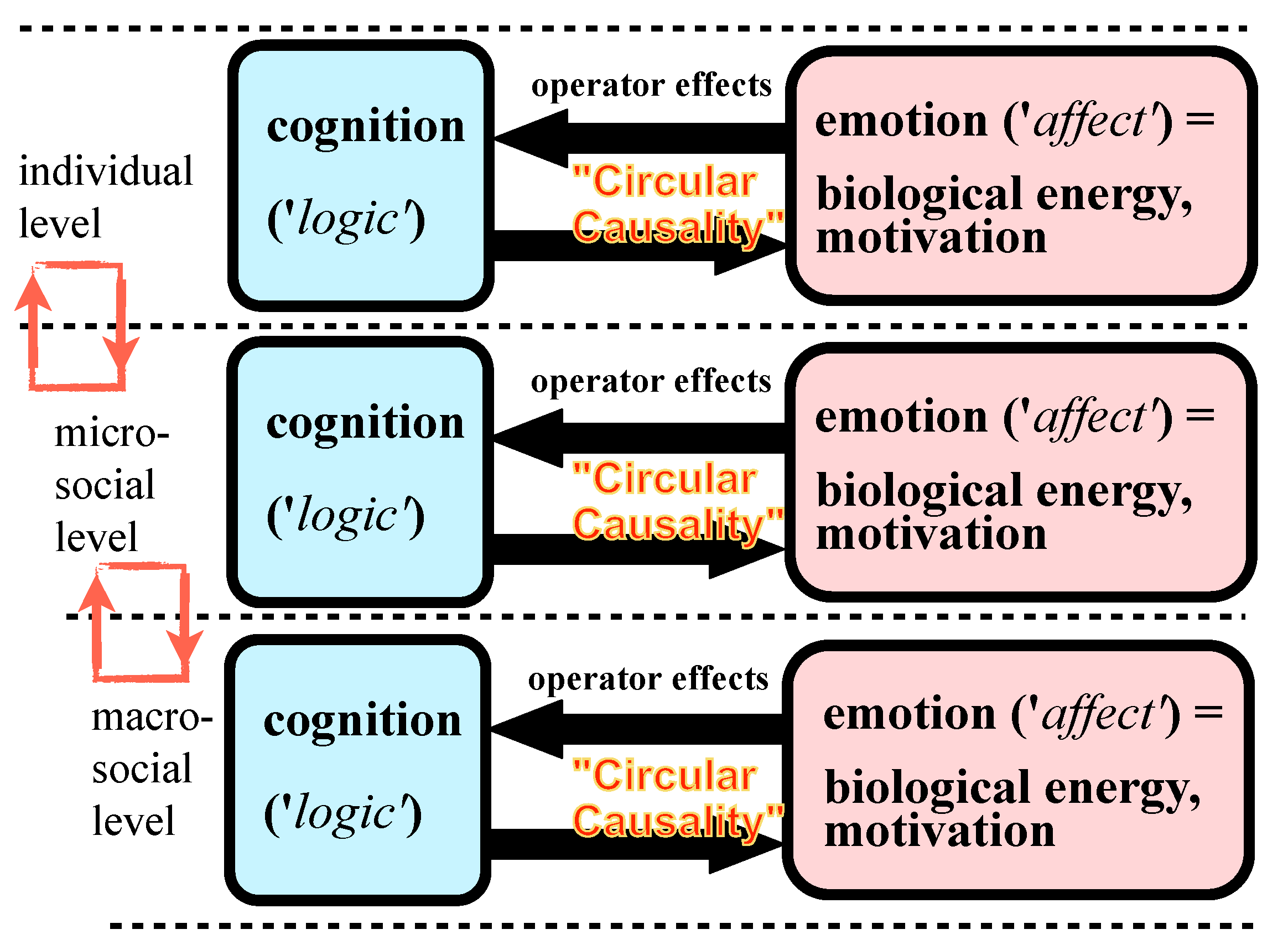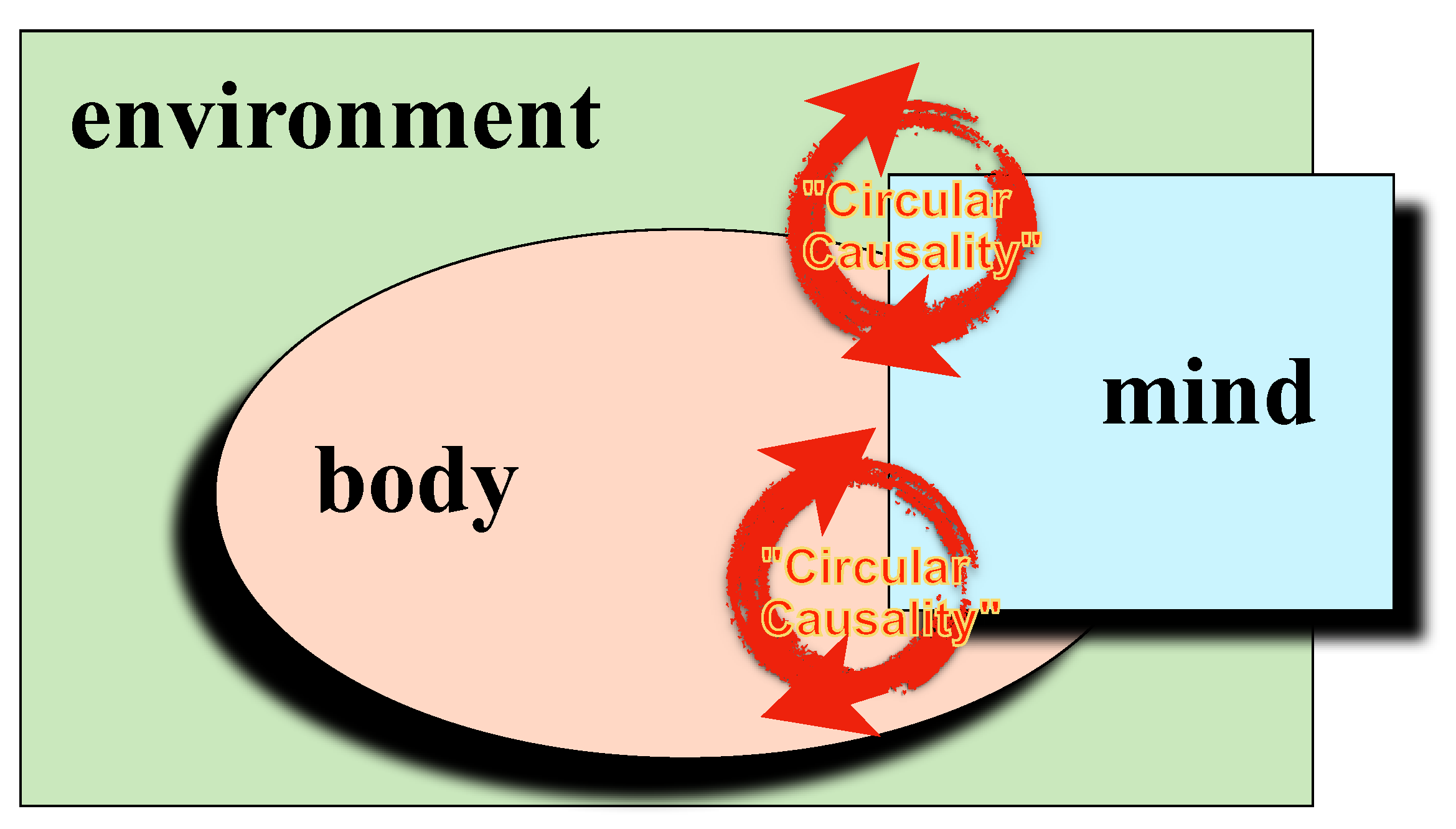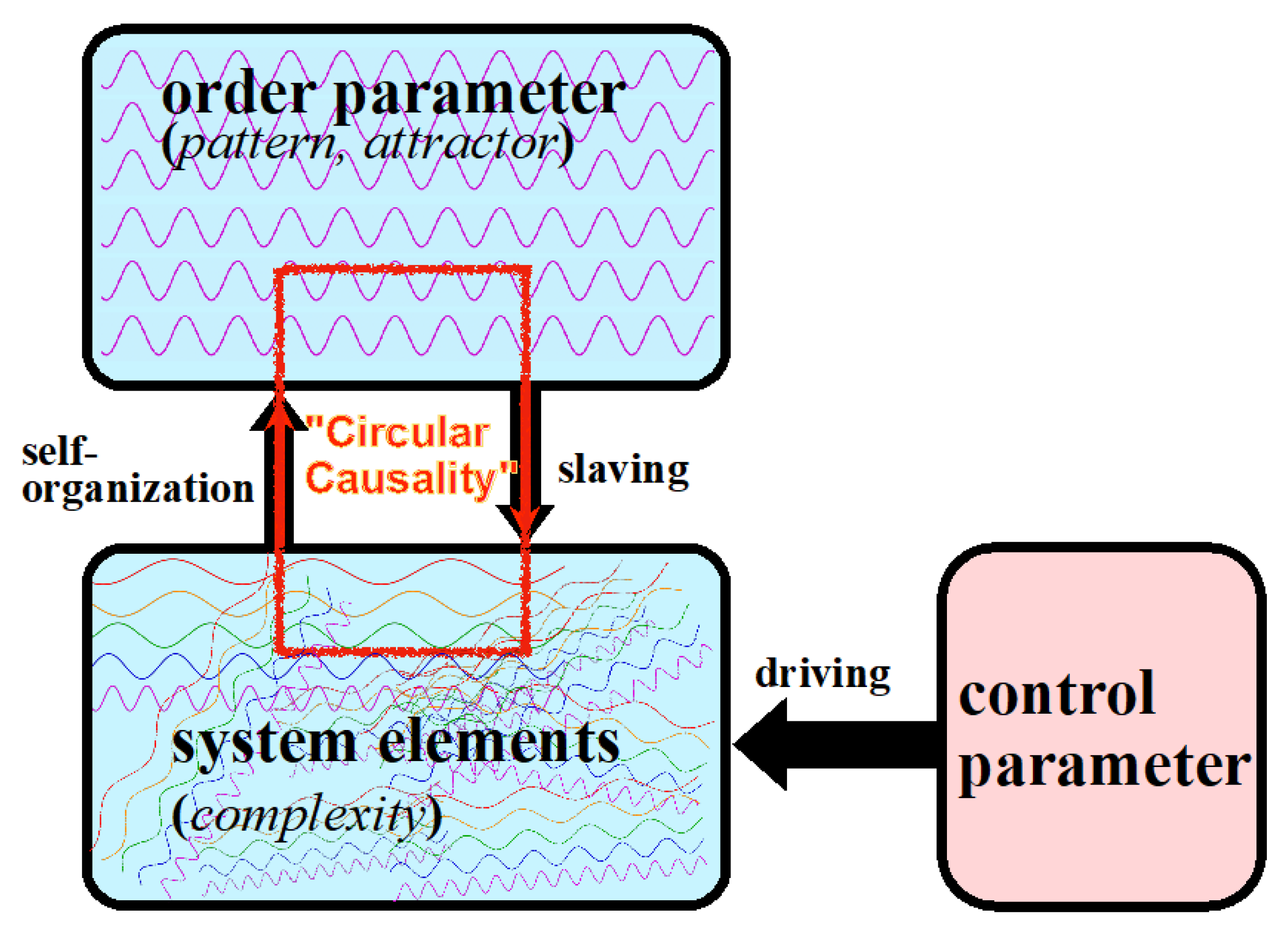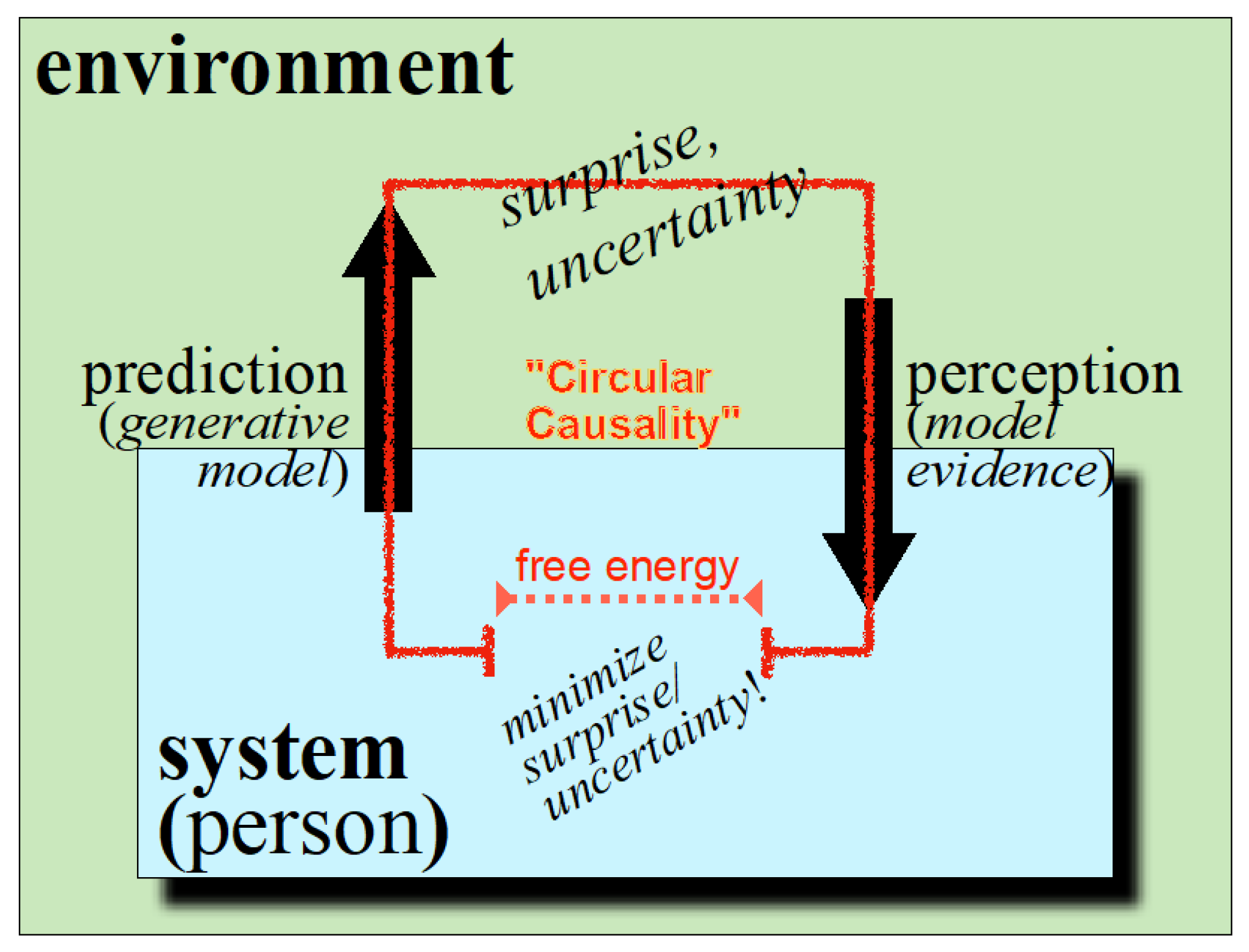Affect-Logic, Embodiment, Synergetics, and the Free Energy Principle: New Approaches to the Understanding and Treatment of Schizophrenia
Abstract
1. Introduction
2. Embodied Cognition
3. Synergetics
4. Free Energy Principle
5. Discussion: Towards a Translational Understanding of Psychosis
6. Therapeutic Implications
7. Open Questions
- Why do certain people react to critically rising emotional tensions with psychotic symptoms, whereas others respond with violence, fall into panic, or become depressed?
- Is there a specific schizophrenogenic vulnerability, and what does it consist of? It was long suspected by the affect-logic perspective, with special reference to Eugen Bleuler’s concept of “loose associations” (cf. disembodiment!), that there may be a partly genetically and partly biographically determined instability of the links between feeling and thinking. Of particular importance are those links that regulate basic interpersonal relations (in psychoanalytic terminology, the object representations). This hypothesis is at least partly supported by recent neurobiological findings revealing disturbed neuronal connections between frontal cortical and subcortical areas, the amygdalae [69].
- There is yet no direct quantitative evidence for the hypothesis that emotional tensions can lead to a phase transition into psychosis, as is proposed by affect-logic. It would be desirable to have objective physiological markers for emotional tension at hand.
- Why does the psychotic phenomenology differ so much from case to case that Eugen Bleuler, the creator of the term schizophrenia in 1911, used to speak of “the group of schizophrenias” [72]? Is this related to the changing influence of a great number of environmental variables or to some genetic or other biological variables?
- As a final and perhaps most important, but to our knowledge astonishingly neglected, question: How do both “spontaneous” and therapy-induced improvements and recoveries arise? According to long-term follow-up studies over several decades [48,50,73], full and lasting recoveries comprise, in the long run, at least one fourth of cases and may even amount to roughly two thirds under especially favorable conditions [51,74].
8. Endnotes
Author Contributions
Funding
Institutional Review Board Statement
Informed Consent Statement
Acknowledgments
Conflicts of Interest
References
- Ciompi, L. The Psyche and Schizophrenia. The Bond between Affect and Logic; Harvard University Press: Cambridge, MA, USA, 1988. [Google Scholar]
- Ciompi, L. Ein blinder Fleck bei Niklas Luhmann. Soziodynamische Wirkungen von Emotionen nach dem Konzept der fraktalen Affektlogik. Soz. Syst. 2004, 10, 21–49. [Google Scholar]
- Ciompi, L.; Bergomi, C. (Eds.) Die Emotionalen Grundlagen des Denkens: Entwurf Einer fraktalen Affektlogik; Vandenhoeck & Ruprecht: Göttingen, Germany, 1997. [Google Scholar]
- Tschacher, W.; Bergomi, C. (Eds.) The Implications of Embodiment: Cognition and Communication; Imprint Academic: Exeter, UK, 2011. [Google Scholar]
- Haken, H. Synergetics: An Introduction; Springer: Berlin/Heidelberg, Germany, 1990. [Google Scholar]
- Haken, H.; Portugali, J. Information and Selforganization: A Unifying Approach and Applications. Entropy 2016, 18, 197. [Google Scholar] [CrossRef]
- Friston, K.J. The free-energy principle: A unified brain theory? Nat. Rev. Neurosci. 2010, 11, 127–138. [Google Scholar] [CrossRef] [PubMed]
- Damasio, A.R. Descartes’ Error: Emotion, Reason, and the Human Brain; Putnam: New York, NY, USA, 1994. [Google Scholar]
- Ciompi, L.; Baatz, M. The energetic dimension of emotions—An evolution-based computer simulation with general implications. Theor. Biol. 2008, 3, 42–50. [Google Scholar] [CrossRef]
- Lewis, M.D. Cognition-emotion feedback and the self-organization of developmental paths. Hum. Dev. 1995, 38, 71–102. [Google Scholar] [CrossRef]
- Maturana, H. Autopoiesis, structural coupling and cognition: A history of these and other notions in the biology of cognition. Cybern. Hum. Knowing 2002, 9, 5–34. [Google Scholar]
- Ciompi, L.; Baatz, M. Do mental processes have a fractal structure? The hypothesis of affect-logic. In Fractals in Biology and Medicine; Losa, A.L., Merline, D., Nonnenmacher, T.F., Weibel, E.R., Eds.; Birkhäuser: Basel, Switzerland, 2005; Volume IV, pp. 107–119. [Google Scholar]
- Ciompi, L.; Endert, E. Gefühle Machen Geschichte: Die Wirkung Kollektiver Emotionen von Hitler bis Obama; Vandenhoeck & Ruprecht: Göttingen, Germany, 2011. [Google Scholar]
- Newen, A.; De Bruin, L.; Gallagher, S. (Eds.) The Oxford Handbook of 4E Cognition; Oxford University Press: Oxford, UK, 2018. [Google Scholar]
- Tschacher, W.; Meier, D. Physiological synchrony in psychotherapy sessions. Psychother. Res. 2020, 30, 558–573. [Google Scholar] [CrossRef] [PubMed]
- Varela, F.; Thompson, E.; Rosch, E. The Embodied Mind. Cognitive Science and Human Experience; MIT Press: Cambridge, UK, 1991. [Google Scholar]
- Wiltshire, T.J.; Philipsen, J.S.; Trasmundi, S.B.; Jensen, T.W.; Steffensen, S.V. Interpersonal coordination dynamics in psychotherapy: A systematic review. Cogn. Ther. Res. 2020, 44, 752–773. [Google Scholar] [CrossRef]
- Michalak, J.; Rohde, K.; Troje, N.F. How we walk affects what we remember: Gait modifications through biofeedback change negative affective memory bias. J. Behav. Ther. Exp. Psychiatry 2015, 46, 121–125. [Google Scholar] [CrossRef]
- Tschacher, W.; Giersch, A.; Friston, K.J. Embodiment and schizophrenia: A review of implications and applications. Schizophr. Bull. 2017, 43, 745–755. [Google Scholar] [CrossRef]
- Süllwold, L. Basis-Störungen. Ergebnisse und offene Fragen. In Schizophrenie, Stand und Entwicklungstendenzen der Forschung; Huber, G., Ed.; Schattauer: Stuttgart, Germany, 1981. [Google Scholar]
- Huber, G. Das Konzept substratnaher Basisstörungen und seine Bedeutung für Theorie und Therapie schizophrener Erkrankungen. Nervenarzt 1983, 54, 23–32. [Google Scholar]
- Fuchs, T. Corporealized and disembodied minds: A phenomenological view of the body in melancholia and schizophrenia. Philos. Psychiatry Psychol. 2005, 12, 95–107. [Google Scholar]
- Fuchs, T.; Schlimme, J.E. Embodiment and psychopathology: A phenomenological perspective. Curr. Opin. Psychiatry 2009, 22, 570–575. [Google Scholar] [CrossRef]
- Parnas, J.; Henriksen, M.G. Disordered self in the schizophrenia spectrum. Harv. Rev. Psychiatry 2014, 22, 251–265. [Google Scholar] [CrossRef] [PubMed]
- Hatfield, E.; Cacioppo, J.T.; Rapson, R.L. Emotional Contagion; Cambridge University Press: Paris, France, 1994. [Google Scholar]
- Haken, H.; Haken-Krell, M. Erfolgsgeheimnisse der Wahrnehmung. Synergetik als Schlüssel zum Gehirn; Deutsche Verlags-Anstalt: Stuttgart, Germany, 1991. [Google Scholar]
- Haken, H.; Portugali, J. Information and Self-Organization II: Steady State and Phase Transition. Entropy 2021, 23, 707. [Google Scholar] [CrossRef] [PubMed]
- Friedenberg, J. Dynamical Psychology: Complexity, Self-Organization and Mind; Emergent Publishing: Litchfield Park, AZ, USA, 2009. [Google Scholar]
- Abraham, R.H.; Shaw, C.D. Dynamics—The Geometry of Behavior; Addison-Wesley: Redwood City, CA, USA, 1992. [Google Scholar]
- Tschacher, W.; Haken, H. The Process of Psychotherapy: Causation and Chance; Springer Nature: Cham, Switzerland, 2019. [Google Scholar]
- Mishara, A.L. Klaus Conrad (1905–1961): Delusional mood, psychosis, and beginning schizophrenia. Schizophr. Bull. 2010, 36, 9–13. [Google Scholar] [CrossRef]
- Bowers, M. Retreat from Sanity: The Structure of Emerging Psychosis; Human Sciences Press: New York, NY, USA, 1974. [Google Scholar]
- Vaughn, C.; Leff, J. The influence of family and social factors on the course of psychiatric illness: A comparison of schizophrenic and depressed neurotic patients. Br. J. Psychiatry 1976, 129, 125–137. [Google Scholar] [CrossRef] [PubMed]
- Kavanagh, D.J. Recent developments in expressed emotion and schizophrenia. Br. J. Psychiatry 1992, 160, 601–620. [Google Scholar] [CrossRef]
- Dohrenwendt, P.; Egri, G. Recent stressful life events and episodes of schizophrenia. Schizophr. Bull. 1981, 7, 12–23. [Google Scholar] [CrossRef]
- Abrahamyan Empson, L.; Baumann, P.S.; Söderström, O.; Codeluppi, Z.; Söderström, D.; Conus, P. Urbanicity: The need for new avenues to explore the link between urban living and psychosis. Early Interv. Psychiatry 2019, 14, 398–409. [Google Scholar] [CrossRef]
- Friston, K.J.; Stephan, K.E. Free-energy and the brain. Synthese 2007, 159, 417–458. [Google Scholar] [CrossRef] [PubMed]
- Palacios, E.F.; Isemura, T.; Friston, K.J. The emergence of synchrony in networks of mutually inferring neurons. Sci. Rep. 2019, 9, 6412. [Google Scholar] [CrossRef] [PubMed]
- von Holst, E.; Mittelstaedt, H. Das Reafferenzprinzip. Wechselwirkung zwischen Zentralnervensystem und Peripherie. Naturwissenschaften 1950, 37, 464–476. [Google Scholar] [CrossRef]
- Piaget, J. Die Äquilibration der Kognitiven Strukturen. [L’équilibration des Structures Cognitives]; Klett: Stuttgart, Germany, 1976. [Google Scholar]
- Lorenz, K. Die Rückseite des Spiegels. In Behind the Mirror: A Search for a Natural History of Human Knowledge; Pieper: München, Germany, 1973. [Google Scholar]
- Silver, A.S. Psychoanalysis and Psychosis: Trends and Developments. J. Contemp. Psychother. 2001, 31, 21–30. [Google Scholar] [CrossRef]
- Wynne, L.C.; Ryckoff, J.; Dave, S.; Hirsch, I. Pseudomutuality in the family relations of schizophrenics. Psychiatry 1958, 21, 205–220. [Google Scholar] [CrossRef]
- Tienari, P.; Sorri, A.; Lathi, I.; Naurala, M.; Wahlberg, K.E.; Pohojola, J.; Moring, J. Interaction of genetic and psychosocial factors in schizophrenia. Acta Psychiatr. Scand. 1985, 71, 19–30. [Google Scholar] [CrossRef] [PubMed]
- Zubin, J.; Spring, B. Vulnerability—A new view on schizophrenia. J. Abnorm. Psychol. 1977, 86, 103–126. [Google Scholar] [CrossRef]
- Nuechterlein, K.H.; Dawson, M.E. A heuristic vulnerability/stress model of schizophrenic episodes. Schizophr. Bull. 1984, 10, 300–312. [Google Scholar] [CrossRef] [PubMed]
- Peters, A.; McEwen, B.S.; Friston, K.J. Uncertainty and stress: Why it causes diseases and how it is mastered by the brain. Prog. Neurobiol. 2017, 156, 164–188. [Google Scholar] [CrossRef] [PubMed]
- Bleuler, M. The Schizophrenic Disorders: Long Term Patient and Family Studies; Yale University Press: New Haven, CT, USA, 1978. [Google Scholar]
- Ciompi, L.; Müller, C. Lebensweg und Alter der Schizophrenen: Eine katamnestische Langzeitstudie; Springer: Berlin, Germany, 1976. [Google Scholar]
- Huber, G.; Gross, G.; Schüttler, R.; Linz, M. Longitudinal studies of schizophrenic patients. Schizophr. Bull. 1992, 6, 592–605. [Google Scholar] [CrossRef]
- Harding, C.M.; Brooks, G.W.; Ashikaga, T.; Strauss, J.S.; Breier, A. The Vermont longitudinal study: II. Long-term outcome of subjects who retrospectively met DSM-III criteria for schizophrenia. Am. J. Psychiatry 1987, 144, 727–735. [Google Scholar] [PubMed]
- Shepherd, A.M.; Laurens, K.R.; Matheson, S.L.; Vaughan, J.C.; Green, M.J. Systematic meta-review and quality assessment of the structural brain alterations in schizophrenia. Neurosci. Biobehav. Rev. 2012, 36, 1342–1356. [Google Scholar] [CrossRef] [PubMed]
- Ciompi, L. The key role of emotions in the schizophrenia puzzle. Schizophr. Bull. 2015, 41, 318–322. [Google Scholar] [CrossRef] [PubMed][Green Version]
- Mosher, L.R.; Menn, A.Z. Community residential treatment for schizophrenia: Two-year follow-up data. Hosp. Community Psychiatry 1978, 29, 715–723. [Google Scholar] [CrossRef]
- Ciompi, L.; Hoffmann, H. Soteria Berne. An innovative milieu therapeutic approach to acute schizophrenia based on the concept of affect-logic. World Psychiatry 2004, 3, 140–146. [Google Scholar]
- Ciompi, L. Soteria Berne: 32 years of experience. An alternative approach to acute schizophrenia. Swiss Arch. Neurol. Psychiatry Psychother. 2017, 168, 10–13. [Google Scholar]
- Ciompi, L.; Dauwalder, H.P.; Maier, C.; Aebi, E.; Trütsch, K.; Kupper, Z.; Rutishauser, C. The pilot project “Soteria Berne”. Clinical experiences and results. Br. J. Psychiatry 1992, 161, 145–153. [Google Scholar] [CrossRef][Green Version]
- Bola, J.R.; Mosher, L. Treatment of acute psychosis without neuroleptics: Two-year outcomes from the Soteria Project. J. Nerv. Ment. Dis. 2003, 191, 219–229. [Google Scholar] [CrossRef]
- Carlton, T.; Ferriter, M.; Hubard, N.; Spandler, H. A systematic review of the Soteria paradigm for the treatment of people diagnosed with schizophrenia. Schizophr. Bull. 2008, 34, 181–192. [Google Scholar] [CrossRef]
- Nischk, D.; Rusch, J. What makes Soteria work? On the effect of therapeutic milieu on self-disturbances in the schizophrenia syndrome. Psychopathology 2019, 52, 213–220. [Google Scholar] [CrossRef] [PubMed]
- Röhricht, F.; Priebe, S. Effect of body-oriented psychological therapy on negative symptoms in schizophrenia: A randomized controlled trial. Psychol. Med. 2006, 36, 669–678. [Google Scholar] [CrossRef] [PubMed]
- Martin, L.A.; Koch, S.C.; Hirjak, D.; Fuchs, T. Overcoming disembodiment: The effect of movement therapy on negative symptoms in schizophrenia—A multicenter randomized controlled trial. Front. Psychol. 2016, 7, 483. [Google Scholar] [CrossRef]
- Pfammatter, M.; Junghan, U.; Brenner, H.D. Efficacy of psychological therapy in schizophrenia: Conclusions from meta-analyses. Schizophr. Bull. 2006, 32, 64–80. [Google Scholar] [CrossRef] [PubMed]
- Bandler, R.; Grinder, J. Patterns of the Hypnotic Techniques of Milton H. Erickson; Meta Publications: Cupertino, CA, USA, 1975. [Google Scholar]
- Davatz, U. ADHS und Schizophrenie: Wie Emotionale Monsterwellen Entstehen und Wie Sie Behandelt Werden; Verlag Rüegger: Chur, Switzerland, 2019. [Google Scholar]
- Ariano, G. La Psicoterapia D’integrazione Strutturale; Armando: Roma, Italy, 1997. [Google Scholar]
- Ariano, G. Dolore per la Crescita; Armando: Roma, Italy, 2005. [Google Scholar]
- Greenberg, L.S.; Watson, J.C. Emotion-Focused Therapy for Depression; American Psychological Association: Washington, DC, USA, 2006. [Google Scholar]
- Comte, M.; Zendjidjian, X.Y.; Coull, J.T.; Cancel, A.; Boutet, C.; Schneider, F.C.; Sage, T.; Lazerges, P.-E.; Jaafari, N.; Ibrahim, E.C.; et al. Impaired cortico-limbic functional connectivity in schizophrenia patients during emotion processing. Soc. Cogn. Affect. Neurosci. 2018, 13, 381–390. [Google Scholar] [CrossRef]
- Friston, K.; Brown, H.R.; Siemerkus, J.; Stephan, K.E. The dysconnection hypothesis. Schizophr. Res. 2016, 176, 83–94. [Google Scholar] [CrossRef]
- Preller, K.H.; Razi, A.; Zeidman, P.; Stämpfli, P.; Friston, K.J.; Vollenweider, F.X. Effective connectivity changes in LSD-induced altered states of consciousness in humans. Proc. Natl. Acad. Sci. USA 2019, 116, 2743–2748. [Google Scholar] [CrossRef] [PubMed]
- Bleuler, E. Dementia Praecox or the Group of Schizophrenias; International University Press: New York, NY, USA, 1950. [Google Scholar]
- Ciompi, L. The natural history of schizophrenia in the long term. Br. J. Psychiatry 1980, 136, 413–420. [Google Scholar] [CrossRef]
- Harding, C.M.; Brooks, G.W.; Ashikaga, T.; Strauss, J.S.; Landerl, P.D. Aging and social functioning in once-chronic schizophrenic patients 21–58 years after first admission: The Vermont Story. In Schizophrenia, Paranoia, and Schizophreniform Disorders in Later Life; Hudgins, G., Miller, N., Eds.; Guilford Press: New York, NY, USA, 1985. [Google Scholar]
- Solms, M. The Conscious Id. Neuropsychoanalysis 2014, 15, 5–19. [Google Scholar] [CrossRef]
- Winn, J.; Bishop, C.M. Variational message passing. J. Mach. Learn. Res. 2005, 6, 661–694. [Google Scholar]




Publisher’s Note: MDPI stays neutral with regard to jurisdictional claims in published maps and institutional affiliations. |
© 2021 by the authors. Licensee MDPI, Basel, Switzerland. This article is an open access article distributed under the terms and conditions of the Creative Commons Attribution (CC BY) license (https://creativecommons.org/licenses/by/4.0/).
Share and Cite
Ciompi, L.; Tschacher, W. Affect-Logic, Embodiment, Synergetics, and the Free Energy Principle: New Approaches to the Understanding and Treatment of Schizophrenia. Entropy 2021, 23, 1619. https://doi.org/10.3390/e23121619
Ciompi L, Tschacher W. Affect-Logic, Embodiment, Synergetics, and the Free Energy Principle: New Approaches to the Understanding and Treatment of Schizophrenia. Entropy. 2021; 23(12):1619. https://doi.org/10.3390/e23121619
Chicago/Turabian StyleCiompi, Luc, and Wolfgang Tschacher. 2021. "Affect-Logic, Embodiment, Synergetics, and the Free Energy Principle: New Approaches to the Understanding and Treatment of Schizophrenia" Entropy 23, no. 12: 1619. https://doi.org/10.3390/e23121619
APA StyleCiompi, L., & Tschacher, W. (2021). Affect-Logic, Embodiment, Synergetics, and the Free Energy Principle: New Approaches to the Understanding and Treatment of Schizophrenia. Entropy, 23(12), 1619. https://doi.org/10.3390/e23121619






